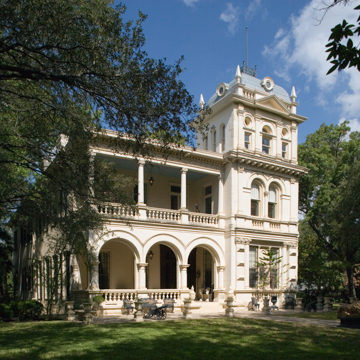The largest of the Italianate-style houses in the neighborhood with its high-quality limestone masonry was built for German immigrant and hardware merchant Russell C. Norton. In c. 1881 the two-story front porches and a rear wing were added by the house's second owner, rancher Edward Polk. According to a rendering of the house by Augustus Koch, in his Bird's Eye View of the City of San Antonio (1873), the Second Empire three-story tower was not present; it is believed it was added during a c. 1891 remodeling, along with a second-story addition to the rear wing. Afterward there was a succession of owners until 1967, when Walter N. Mathis purchased the residence and renamed it “Villa Finale.” Mathis, famed locally for his art collections, restored thirteen other residences in the King William District. Upon his death in 2005, Villa Finale was donated to the National Trust for Historic Preservation as the first National Trust Historic site in Texas. Restoration was completed in 2010 and the house opened to the public.
You are here
Norton-Polk-Mathis House, “Villa Finale”
1876, Francis Crider; c. 1881 additions; c. 1891 remodeled; 2010 restoration. 401 King William St.
If SAH Archipedia has been useful to you, please consider supporting it.
SAH Archipedia tells the story of the United States through its buildings, landscapes, and cities. This freely available resource empowers the public with authoritative knowledge that deepens their understanding and appreciation of the built environment. But the Society of Architectural Historians, which created SAH Archipedia with University of Virginia Press, needs your support to maintain the high-caliber research, writing, photography, cartography, editing, design, and programming that make SAH Archipedia a trusted online resource available to all who value the history of place, heritage tourism, and learning.















